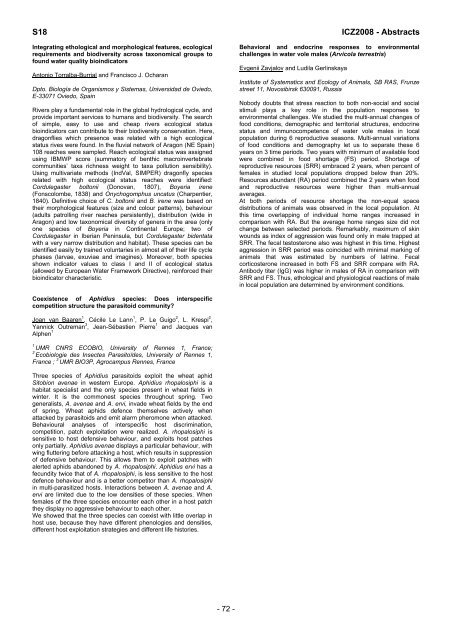CONTENT - International Society of Zoological Sciences
CONTENT - International Society of Zoological Sciences
CONTENT - International Society of Zoological Sciences
Create successful ePaper yourself
Turn your PDF publications into a flip-book with our unique Google optimized e-Paper software.
S18 ICZ2008 - Abstracts<br />
Integrating ethological and morphological features, ecological<br />
requirements and biodiversity across taxonomical groups to<br />
found water quality bioindicators<br />
Antonio Torralba-Burrial and Francisco J. Ocharan<br />
Dpto. Biología de Organismos y Sistemas, Universidad de Oviedo,<br />
E-33071 Oviedo, Spain<br />
Rivers play a fundamental role in the global hydrological cycle, and<br />
provide important services to humans and biodiversity. The search<br />
<strong>of</strong> simple, easy to use and cheap rivers ecological status<br />
bioindicators can contribute to their biodiversity conservation. Here,<br />
dragonflies which presence was related with a high ecological<br />
status rives were found. In the fluvial network <strong>of</strong> Aragon (NE Spain)<br />
108 reaches were sampled. Reach ecological status was assigned<br />
using IBMWP score (summatory <strong>of</strong> benthic macroinvertebrate<br />
communities’ taxa richness weight to taxa pollution sensibility).<br />
Using multivariate methods (IndVal, SIMPER) dragonfly species<br />
related with high ecological status reaches were identified:<br />
Cordulegaster boltonii (Donovan, 1807), Boyeria irene<br />
(Fonscolombe, 1838) and Onychogomphus uncatus (Charpentier,<br />
1840). Definitive choice <strong>of</strong> C. boltonii and B. irene was based on<br />
their morphological features (size and colour patterns), behaviour<br />
(adults patrolling river reaches persistently), distribution (wide in<br />
Aragon) and low taxonomical diversity <strong>of</strong> genera in the area (only<br />
one species <strong>of</strong> Boyeria in Continental Europe; two <strong>of</strong><br />
Cordulegaster in Iberian Peninsula, but Cordulegaster bidentata<br />
with a very narrow distribution and habitat). These species can be<br />
identified easily by trained voluntaries in almost all <strong>of</strong> their life cycle<br />
phases (larvae, exuviae and imagines). Moreover, both species<br />
shown indicator values to class I and II <strong>of</strong> ecological status<br />
(allowed by European Water Framework Directive), reinforced their<br />
bioindicator characteristic.<br />
Coexistence <strong>of</strong> Aphidius species: Does interspecific<br />
competition structure the parasitoid community?<br />
Joan van Baaren 1 , Cécile Le Lann 1 , P. Le Guigo 2 , L. Krespi 2 ,<br />
Yannick Outreman 3 , Jean-Sébastien Pierre 1 and Jacques van<br />
Alphen 1<br />
1 UMR CNRS ECOBIO, University <strong>of</strong> Rennes 1, France;<br />
2 Ecobiologie des Insectes Parasitoïdes, University <strong>of</strong> Rennes 1,<br />
France ; 3 UMR BIO3P, Agrocampus Rennes, France<br />
Three species <strong>of</strong> Aphidius parasitoids exploit the wheat aphid<br />
Sitobion avenae in western Europe. Aphidius rhopalosiphi is a<br />
habitat specialist and the only species present in wheat fields in<br />
winter. It is the commonest species throughout spring. Two<br />
generalists, A. avenae and A. ervi, invade wheat fields by the end<br />
<strong>of</strong> spring. Wheat aphids defence themselves actively when<br />
attacked by parasitoids and emit alarm pheromone when attacked.<br />
Behavioural analyses <strong>of</strong> interspecific host discrimination,<br />
competition, patch exploitation were realized. A. rhopalosiphi is<br />
sensitive to host defensive behaviour, and exploits host patches<br />
only partially. Aphidius avenae displays a particular behaviour, with<br />
wing fluttering before attacking a host, which results in suppression<br />
<strong>of</strong> defensive behaviour. This allows them to exploit patches with<br />
alerted aphids abandoned by A. rhopalosiphi. Aphidius ervi has a<br />
fecundity twice that <strong>of</strong> A. rhopalosiphi, is less sensitive to the host<br />
defence behaviour and is a better competitor than A. rhopalosiphi<br />
in multi-parasitized hosts. Interactions between A. avenae and A.<br />
ervi are limited due to the low densities <strong>of</strong> these species. When<br />
females <strong>of</strong> the three species encounter each other in a host patch<br />
they display no aggressive behaviour to each other.<br />
We showed that the three species can coexist with little overlap in<br />
host use, because they have different phenologies and densities,<br />
different host exploitation strategies and different life histories.<br />
- 72 -<br />
Behavioral and endocrine responses to environmental<br />
challenges in water vole males (Arvicola terrestris)<br />
Evgenii Zavjalov and Ludila Gerlinskaya<br />
Institute <strong>of</strong> Systematics and Ecology <strong>of</strong> Animals, SB RAS, Frunze<br />
street 11, Novosibirsk 630091, Russia<br />
Nobody doubts that stress reaction to both non-social and social<br />
stimuli plays a key role in the population responses to<br />
environmental challenges. We studied the multi-annual changes <strong>of</strong><br />
food conditions, demographic and territorial structures, endocrine<br />
status and immunocompetence <strong>of</strong> water vole males in local<br />
population during 6 reproductive seasons. Multi-annual variations<br />
<strong>of</strong> food conditions and demography let us to separate these 6<br />
years on 3 time periods. Two years with minimum <strong>of</strong> available food<br />
were combined in food shortage (FS) period. Shortage <strong>of</strong><br />
reproductive resources (SRR) embraced 2 years, when percent <strong>of</strong><br />
females in studied local populations dropped below than 20%.<br />
Resources abundant (RA) period combined the 2 years when food<br />
and reproductive resources were higher than multi-annual<br />
averages.<br />
At both periods <strong>of</strong> resource shortage the non-equal space<br />
distributions <strong>of</strong> animals was observed in the local population. At<br />
this time overlapping <strong>of</strong> individual home ranges increased in<br />
comparison with RA. But the average home ranges size did not<br />
change between selected periods. Remarkably, maximum <strong>of</strong> skin<br />
wounds as index <strong>of</strong> aggression was found only in male trapped at<br />
SRR. The fecal testosterone also was highest in this time. Highest<br />
aggression in SRR period was coincided with minimal marking <strong>of</strong><br />
animals that was estimated by numbers <strong>of</strong> latrine. Fecal<br />
corticosterone increased in both FS and SRR compare with RA.<br />
Antibody titer (IgG) was higher in males <strong>of</strong> RA in comparison with<br />
SRR and FS. Thus, ethological and physiological reactions <strong>of</strong> male<br />
in local population are determined by environment conditions.


